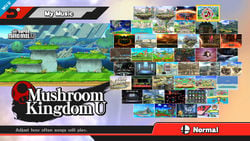My Music

- Not to be confused with the alternate music available in Super Smash Bros. Melee and Super Smash Bros. for Nintendo 3DS.
My Music (オレ曲セレクト, My Music Selecting) is an option in Super Smash Bros. Brawl, Super Smash Bros. for Wii U, and Super Smash Bros. Ultimate that allows the player to choose any music track for any stage and adjust the likeliness that track will appear in that stage when battled on. This concept is similar to holding L and R in Melee in certain stages, except that this mode can be done at any time, and there are more than two tracks for each stage (excluding the stage Hanenbow in Brawl, which makes its own music with an ambient track as its backdrop and Midgar, which only has two tracks). Several tracks can be unlocked for each stage, either through collecting CDs or meeting certain pre-set conditions.
Contrary to its appearance, setting a track's slider to its far left does not render the chances of that particular track playing to none; rather, it makes the chances of that particular track playing exceedingly small.
In Ultimate, My Music does not restrict songs to stages so long as they are from the same series. For example, all Zelda stages share the same track list which can then be adjusted to the player's preference. Ultimate also allows the ability to choose which song that will play for a particular match.
Trivia
- The Castle / Boss Fortress (Super Mario World / SMB 3) music track was initially present on the Delfino Plaza stage as proven by a beta screenshot of this menu item in the Smash Bros. DOJO!!, but the developers moved it to the Luigi's Mansion stage for the finished product. The track was also called Castle Music / Fortress Boss in this screenshot.
- Originally in Super Smash Bros. for Wii U, Skyloft had Ocarina of Time Medley play, before being moved back to Bridge of Eldin.
- Three track titles were changed in Super Smash Bros. for Wii U: "Ballad of the Goddess/Ghirahim's Theme" was originally just "Ballad of the Goddess", "Saria's Song/Middle Boss Battle" was originally just "Saria's Song", and "Bramble Blast" from Brawl was changed to "Stickerbush Symphony".
- In pre-release versions of Super Smash Bros. for Wii U, songs were labeled as "Arrangement" rather than "Remix".
- Some stages in Super Smash Bros. for Wii U have sliders in My Music featuring certain peculiarities:
- Miiverse does not have a song set at 100% by default. Also, "Mii Plaza" "Mario Paint Medley" and "Tomodachi Life" are tied in likeliness by default.
- Flat Zone X has two songs set at 100% by default.
- Suzaku Castle's first song in My Music, "Ryu Stage", is not set to be the most likely by default.
- Boxing Ring has the song "Tomorrow's Passion" set at 0% by default.
- When Corrin is purchased, both versions of "Lost in Thoughts All Alone" will be added to Coliseum and Castle Siege at 0%. Despite this, choosing to reset the probabilities to default will grant them pre-set probabilities. These are the only songs with this peculiarity.
- In Super Smash Bros. Ultimate, songs are generally prioritized with two specific music pieces, then the remaining music in the order listed in Sounds. There are, however, exceptions:
- Luigi's Mansion prioritizes music from the titular game and its sequel.
- Mario Bros. prioritizes music from Dr. Mario.
- Paper Mario prioritizes music from the Mario RPGs (with the odd exception of Gritzy Desert).
- Mario Galaxy prioritizes music from Super Mario Galaxy and its sequel.
- Super Mario Maker focuses on the direct ports of the themes for Super Mario Bros., Super Mario World, and New Super Mario Bros. U.
- Pirate Ship and Spirit Train prioritize music from Zelda games with the cel-shaded, cartoony art style.
- In all non-Japanese versions, all songs retain their English names, even the ones that canonically have their own names in other languages.
Gallery
The My Music interface for Battlefield in Brawl.
The My Music interface for Mushroom Kingdom U in Super Smash Bros. for Wii U.
- My music.png
The My Music interface for Moray Towers in Super Smash Bros. Ultimate.
| Super Smash Bros. Brawl menu items | |
|---|---|
| Group | Brawl (Time · Stock · Coin Battle · Team Battle) · Rules · Special Brawl · Rotation · Tourney · Names |
| Solo | Classic · All-Star · Adventure Mode: The Subspace Emissary · Events · Stadium (Target Smash!! · Home-Run Contest · Multi-Man Brawl · Boss Battles) · Training |
| Wi-Fi | Spectator Mode · With Anyone · With Friends |
| Vault | Trophies & Stickers (Trophy Gallery · Trophy Hoard · Coin Launcher · Sticker Album · Sticker Center) · Stage Builder · Album · Challenges · Replays · Masterpieces · Chronicle |
| Options | Screen · Deflicker · Rumble · Controls · Sound · My Music · Erase Data |
| Data | Movies · Records (Group Records · Brawl Records · Notices) · Sound Test |
| Super Smash Bros. for Wii U menu items | |
|---|---|
| Smash | Smash (Time · Stock · Coin Battle · Team Battle) · 8-Player Smash · Special Smash · Rules · Controls |
| Games & More | Classic · All-Star · Stadium (Target Blast · Home-Run Contest · Multi-Man Smash) · Training · Events · Special Orders (Master Orders · Crazy Orders) · Custom · Stage Builder · amiibo · Vault (Trophies · Trophy Rush · Album · Replays · Movies · Sounds · Records · Tips · Masterpieces) · Options (Controls · Sound · My Music · Internet Options) |
| Online | Spectator Mode · With Anyone (For Fun · For Glory) · With Friends · Online Events (Tourney · Conquest) · Share |
| Other | Challenge · Smash Tour · 3DS |



